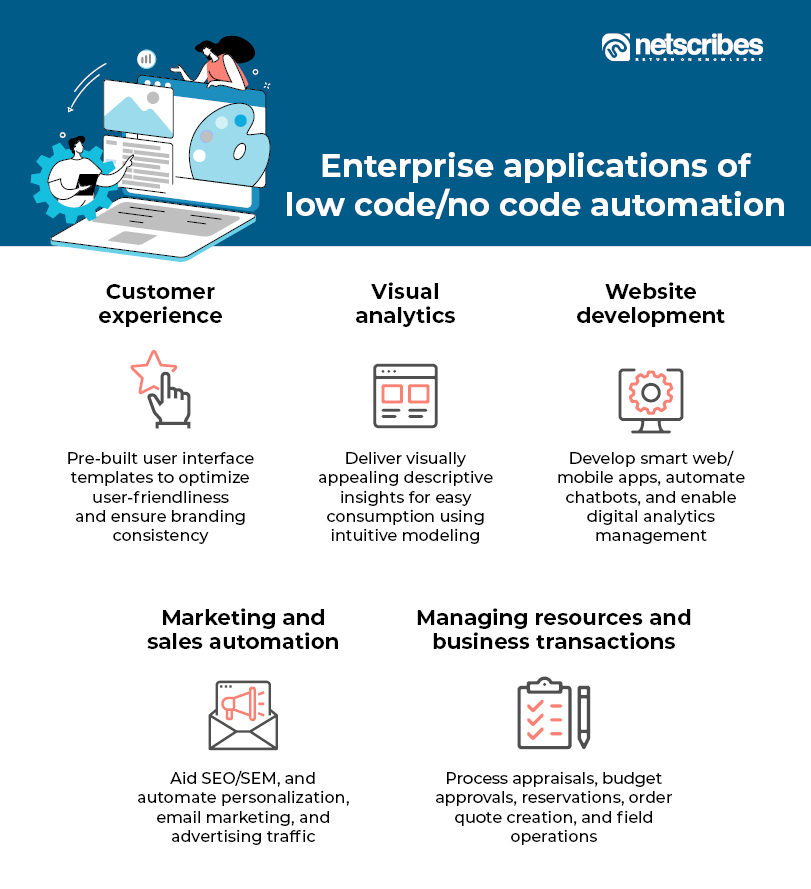Recommended Reasons On Selecting application development with Low-code platforms
Recommended Reasons On Selecting application development with Low-code platforms
Blog Article
The Benefits Of Low-Code Development For Speed
Visual Development Environment :
Drag-and-Drop Interfaces: Low-code platforms provide visual tools for designing applications. Drag-and drop components can be used by developers to quickly assemble apps without coding.
Pre-built Templates and Components Many low-code platforms come with templates and components that are pre-built, which enable developers to swiftly develop and test applications without having to start from the beginning.
Coding Requirements Reduced
Automated Code Generation Low-code platforms automatically create the code base on the visual models designed by developers. This eliminates the requirement to write code manually and speed up the process of development.
Reusable Parts: Developers will have the ability to reuse parts that are reusable across different projects, and cut down on the time needed for writing and testing of code.
Collaboration is made easier:
Low-code platforms have a myriad of tools to facilitate seamless collaboration between development teams. They include testing, version control and deployment.
Citizen Development (Citizen Development) User and non-developers of business applications can participate in the development of applications making use of intuitive interfaces. This reduces the burden caused by a lack of professional developer availability.
Rapid Iteration, Prototyping:
Rapid Prototyping: Designers can quickly create prototypes to validate ideas and get feedback, which results in faster iteration cycles.
Easy Modifications: Low-code development is oriented towards visuals, which makes it easier to change and update apps. It helps speed up the process for developing and improving applications based on feedback from users.
Pre-built Integrations:
API Integrations. A lot of low-code platforms have connectors designed for the most the most popular APIs and other services. This can speed up the process of integrating systems.
Data integration: Tools to integrate data are included to help simplify the process.
Scaling and deployment:
One-Click deployment: Many platforms that make use of low-code have the option of deploying with one click applications, which can reduce the time and effort.
Cloud-Based Platforms: Cloud-based platforms that have low-code capabilities can manage infrastructure and scaling, so developers can concentrate on the application logic and function rather than deployment logistics.
The primary benefit of low-code application development in terms of speed, is its ability to automate and simplify many aspects of the process. This enables faster delivery of applications, and more rapid adaptation to changing demands. Read the best such a good point about Low-code Platform for application development for site tips including push alerts, develop web app, jdbc server, app modernisation, low code development platforms, mobile development platforms, ms azure sql, cross platform app dev, build a docker container, build a docker container and more.
The Benefits Of Low-Code Development In Terms Scalability, Flexibility And Scalability
Low-code development of applications offers a variety of advantages in terms of adaptability and scalability, which are crucial for building applications that expand with the needs of businesses and change with the demands of business. Here are three key benefits.
Cloud-Based deployment: Many lowcode applications are built on the cloud, which enables applications to scale up with the infrastructure. This allows companies to handle increasing loads without worrying over the management of servers.
Auto-Scaling Features: Built-in auto scaling capabilities automatically alter resources in accordance with the requirements. This allows for constant performance during peak periods without the need for manual intervention.
Flexible Architecture:
Modular Design: Low-code platforms encourage modular design of applications, in which components can be developed independently as well as tested and scaled. Modularity allows for greater flexibility, and it's easier to modify specific elements of an application without having to change the entire system.
Microservices Integration : In support of microservices architecture, applications can be created using loosely-coupled service to improve flexibility and scalability.
Solutions that can be customized:
Flexibility : Low-code platforms allow developers to expand functionality beyond the standard features. This allows the satisfaction of business needs that are unique without limits.
Third-Party Integrations: Integration to third-party APIs and services enables businesses to add additional functions to their applications.
Agile Development and Deployment
Continuous Delivery & Deployment Low-code Platforms can support agile methods through enabling continuous integration and Continuous Delivery (CI/CD). This enables rapid deployment of updates and new features, allowing applications to grow quickly as a result of customer feedback and changes to the market.
Iterative Development - This low-code approach lets applications be upgraded and scaled gradually, reducing risk and allowing for more controlled expansion.
Resource Optimization
Efficient Resources Management Low Code platforms maximize resource utilization by using tools that monitor and control the performance of applications. This will ensure that resources are used efficiently. They can also be scaled up or down in accordance with the actual requirements.
Load Balancing: Integrated load balancing capabilities distribute the burden evenly across servers, enhancing the application's ability to handle high traffic and ensuring the same performance.
Global Reach
Multi-Region availability: Lowcode platforms permit the deployment of applications across different regions. Businesses can offer users low-latency access to the world. This is crucial, particularly for applications that serve global users.
Localization Support: Built-in support for localization lets applications easily be adapted to different local languages and requirements, enhancing their flexibility in diverse markets.
Updates and maintenance:
Maintenance is simplified by the modularity and visual appeal of low-code applications makes maintenance easier which allows quick fixes and updates to be implemented without lengthy downtime.
Version Control Systems for Controlling Versions can assist you in managing updates, rollbacks and changes. They can make sure that they are released safely and previous version is restored as needed.
Cost Efficiency:
Low Development Costs: By decreasing the amount of programming required, low code platforms can reduce the development cost. This allows you to scale up applications without increasing the development effort and expenditure.
Pay-As.-You-Go A lot of lowcode platforms provide flexible pricing models, including pay-as.-you-go. They align costs to actual usage and growth in order to give financial flexibility.
The flexibility of low-code apps allows businesses to develop robust, adaptable, scalable, and durable applications. These platforms enable quick adaptations to changing needs, efficient resource usage, and continual advancement. This guarantees that the application can evolve with the needs of the business. View the most popular Legacy application modernization with Low-code url for blog advice including develop web app, low code platforms, app platforms, mobile development platforms, jdbc server, software for app development, application modernization, database in azure, azure sql, app dev platform and more.
In Terms Of Vendor Support And Community Involvement, Low-Code Development Offers Many Benefits.
Low-code development platforms have significant advantages in terms of support for vendors as well as the community. These are crucial for successful implementations, ongoing maintenance, as well as continuous improvement. Here are some key advantages.
Comprehensive Technical Support:
Dedicated Support Teams: Many low-code platforms have access to dedicated support teams that can assist in technical problems, troubleshooting, and provide guidance to ensure that all issues are solved promptly.
Help is accessible 24/7. Numerous vendors offer round-the-clock support, which can be particularly beneficial for companies that operate across different time zones.
Training and Onboarding
Structured training programs: Vendors offer structured training courses, such as webinars or courses for certification. This helps users quickly get to grips with the platform.
Personalized Onboarding: Many vendors offer personalized onboarding to assist new customers implement the platform effectively and tailor it to their particular needs.
Updates and Enhancements, Regularly, and Enhancements:
Continuous Improvement : Low-code platform manufacturers often release regular updates that include new functionality as well as performance improvements and security patches. These updates make sure that their platform remains current and secure.
Feedback Integration: Vendors include feedback from users into their development cycles to ensure that the platform is evolving to meet the ever-changing needs of its users.
Comprehensive Documentation:
Comprehensive Documentation: A comprehensive and well-organized documents are usually available that covers everything from basic usage to advanced customization. This allows users to solve problems without assistance.
API References: API documentation is detailed and aids developers in integrating APIs with other platforms, as well as customize their applications.
Professional and Consulting Services
Expert Consultation: Vendors frequently provide consulting services that assist in the process of strategic planning architectural design, as well as complicated implementations, to ensure that users have the ability to leverage the platform to its fullest potential.
Custom Development Services: A few vendors offer customized development to develop features or integrations for their clients that are not readily accessible.
Community Support
Active User Communities
Forums and Discussion Boards: Numerous low-code platforms have lively online communities that allow users to discuss issues, ask questions, and share solutions, and collaborate on the best practices.
Local and virtual User Groups: These groups offer opportunities to connect, share knowledge and share experiences.
Knowledge Sharing & Collaboration:
Community-Contributed Resources: Users often share templates, modules, and extensions that they have developed, which can be reused or adapted by others, accelerating development and innovation.
Crowdsourced Problem-Solving: The collective wisdom and collective knowledge of a community can be an invaluable source to solve problems and find creative solutions for complicated problems.
Learning and Development:
Community-led training Community-led training: Many groups provide training sessions, webinars, and workshops led by experts who are experts in their area.
Online Tutorials: Community members create and share many online tutorials, how-tos, and classes. These tutorials are made available to everyone.
Feedback and Influence
Product Feedback: Many forums have channels for giving feedback to manufacturers. This could influence the development of the development of new features and enhancements.
Beta Testing members of active communities might be eligible to take part. This gives them early access and be involved in the creation of the platform.
Recognition and support
A lot of vendors offer community recognition programs. These programs recognize active community members, and can include MVP programs.
Support from peers: Community members will often offer peer-to-peer support, offering their expertise and guidance to those who may be less knowledgeable. They help create a supportive atmosphere by encouraging the spirit of collaboration and building a community.
In the end, the combination of of robust vendor support with an active and engaged community creates a comprehensive support eco-system for low code application development. The developers will benefit from the experience and resources needed to build, deploy and maintain their application.